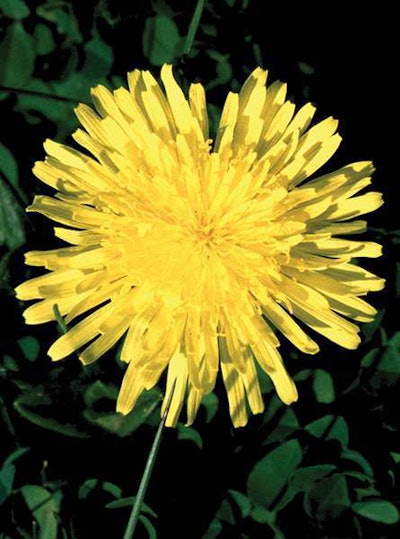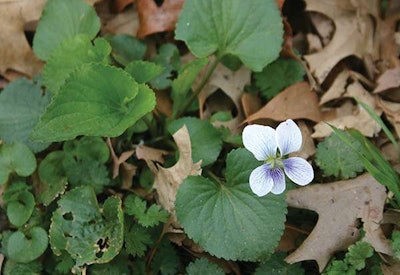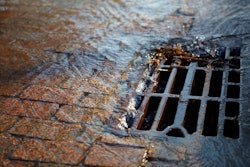 Photo courtesy of Ohio State Weed Lab Archive, The Ohio State University, Bugwood.org
Photo courtesy of Ohio State Weed Lab Archive, The Ohio State University, Bugwood.orgIf summer’s high temperatures and drought-like conditions have forced you to put weed control on hold, don’t panic. You still have time to take aim at weeds. In fact, for certain broadleaf weed herbicide applications, later is greater.
“Fall is a much better time to control some of the hardiest and most durable perennial broadleaf weeds because they are actively growing in cool-season turfgrasses,” says Ken Hutto, Ph.D., technical service manager for FMC Professional Solutions. It’s the active growing that promotes the spread of the herbicide throughout the weed plant.
Targeting these weeds in the fall not only boosts herbicide efficacy for a more complete kill of weeds, but also decreases the chance of damaging turf, which has only just recovered from the stresses of summer. Taking weeds out in the fall can give turf a competitive advantage when it emerges in the spring and break the weed cycle.
A fall fix
In many instances, trying to combat weeds in the summer is not only futile, but it can damage turfgrass, according to Aaron Patton, Ph.D., associate professor and turfgrass extension specialist at Purdue University.
“Herbicides are most effective on weeds that are not drought-stressed, and herbicides can be damaging when applied to drought-stressed turf,” Patton says.
Instead, a fall application minimizes the risks to turf and maximizes efficacy, taking advantage of the weed’s lifecycle.
“Many herbicides are effective in late fall because plants are more likely to translocate (move downward) herbicides into root and stem tissues as the day lengths shorten and temperatures cool,” Patton says.
While preparing for winter, weeds are storing energy reserves and will readily suck up herbicides.
 Wild violet is more susceptible to herbicides in the fall when it is actively growing. Photo courtesy of Walter Reeves, The Georgia Gardener
Wild violet is more susceptible to herbicides in the fall when it is actively growing. Photo courtesy of Walter Reeves, The Georgia Gardener“When weeds are actively growing in the fall, it’s easy for them to metabolize herbicides. These perennial weeds are shifting their requirements to productive growth. They are sucking in nutrients and moisture,” Hutto says.
Weeds like dandelion, clover, plantain, ground ivy and wild violet are all good candidates for fall weed control.
“Wild violet has a pretty nasty rhizome to reproduce vegetatively. It’s shifting carbohydrates down into tubers in the fall to be ready to emerge in the spring, so by making a fall application, the product is drawn down into the reproductive areas,” Hutto says.
Not only is fall herbicide application appropriate, for some weeds, like wild violet, it has proven to be the most effective time for control. According to Hutto, research comparing fall versus spring herbicide application for wild violet has rated fall the prime time.
For other broadleaf perennial weeds, you can reach the same level of control whether you time your herbicide application for fall or spring. In these instances, fall can still be a better option.
“The major benefit of all weed control is removing competition from turfgrass,” Hutto says. “What that allows you to do is increase competitive advantage of turf in the fall. If you remove the weeds and you’re fertilizing, those voids can be filled back in, and you’re going into the winter with much healthier turf. So, you’re going into spring with a denser turf, and you’ll do better overall with weeds.”
Time and temperature
Before planning your fall herbicide application, you first must consider whether you’ll put down seed in the fall. If you’re going to seed, you’ll need to time your application early enough so that it won’t interfere.
Always consult the product label, which will provide specific instructions and restrictions for seeding. With some products, the wait between application and seeding will be minimal. For other products, it could be as long as 30 days.
 This fall is the best time to control perennial broadleaf weeds, like plantain, with two-or three-way herbicide combinations. Photo courtesy of Auburn University, College of Agriculture
This fall is the best time to control perennial broadleaf weeds, like plantain, with two-or three-way herbicide combinations. Photo courtesy of Auburn University, College of AgricultureNo matter the wait, controlling weeds before seeding is always a good idea.
“If you’re seeding into a lawn and you remove weeds prior to seeding, you’ll get much better seed-to-soil contact,” Hutto says. “If weeds are present, you won’t get as good establishment. If voids are created by eliminating weeds, much more seed can fill in the gaps. That’s the greatest benefit of fall weed control, whether in established lawns with spot treatment or by reseeding.”
From a general weed-control standpoint, temperatures will be a critical factor in the amount of control you’ll get in the fall. You shouldn’t apply herbicide when temperatures fall below 55 degrees Fahrenheit. Labels will provide more specific information.
“As it gets colder, weeds will start dying off and the application won’t be as effective,” Hutto says.
You’ll also want to consider the product you’re using and length of control. Some of the most common active ingredients for fall control include 2,4-D + MCPP + dicamba, triclopyr and sulfentrazone + quinclorac. Some products will get you as many as 60 days of control before the first frost hits.
Herbicide formulation will also determine the level of control you’ll get from your fall application, according to Hutto.
“As you get into cooler temperatures, companies switch to an ester formulation versus an amine formulation,” Hutto says. “Esters hold up better to the cooler temperatures and penetrate the cuticles. That’s another thing to consider for fall application.”
Lastly, fertilization is key to ultimately getting rid of weeds in the fall.
“In the rules of weed control, the first step is always competitive turf,” Hutto says. “By coupling weed control with fall fertilization, it increases the competition of turf while decreasing the weeds. That’s an important part.”










